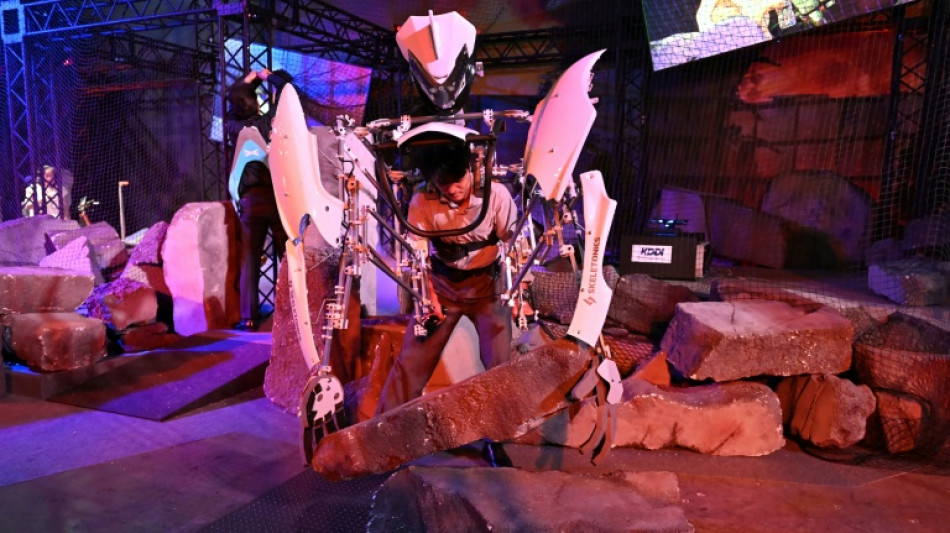
-
 Dutch police use hologram to try and decode sex worker's murder
Dutch police use hologram to try and decode sex worker's murder
-
Israel bombs south Beirut after Hezbollah targets Haifa area

-
 Biden in historic Amazon trip as Trump return sparks climate fears
Biden in historic Amazon trip as Trump return sparks climate fears
-
India hails 'historic' hypersonic missile test flight

-
 Israel orders Beirut residents to flee after Hezbollah targets Haifa area
Israel orders Beirut residents to flee after Hezbollah targets Haifa area
-
Davis, LeBron power Lakers over Pelicans as Celtics win in OT

-
 Trump and allies return to New York for UFC fights
Trump and allies return to New York for UFC fights
-
Hong Kong political freedoms in spotlight during bumper trial week

-
 Debt-saddled Laos struggles to tame rampant inflation
Debt-saddled Laos struggles to tame rampant inflation
-
Senna, Schumacher... Beganovic? Macau GP showcases future F1 stars

-
 India's vinyl revival finds its groove
India's vinyl revival finds its groove
-
G20 tests Brazil's clout in Lula 3.0 era

-
 Over 20,000 displaced by gang violence in Haiti: UN agency
Over 20,000 displaced by gang violence in Haiti: UN agency
-
Famed gymastics coach Bela Karolyi dies

-
 'Break taboos': Josep Borrell wraps up time as EU's top diplomat
'Break taboos': Josep Borrell wraps up time as EU's top diplomat
-
Climate finance can be hard sell, says aide to banks and PMs

-
 Trump revives 'peace through strength,' but meaning up to debate
Trump revives 'peace through strength,' but meaning up to debate
-
New York auction records expected for a Magritte... and a banana

-
 Egypt's middle class cuts costs as IMF-backed reforms take hold
Egypt's middle class cuts costs as IMF-backed reforms take hold
-
Beirut businesses struggle to stay afloat under Israeli raids

-
 Dupont lauds France 'pragmatism' in tight New Zealand win
Dupont lauds France 'pragmatism' in tight New Zealand win
-
Swiatek leads Poland into maiden BJK Cup semi-final

-
 Trump taps fracking magnate and climate skeptic as energy chief
Trump taps fracking magnate and climate skeptic as energy chief
-
West Indies restore pride with high-scoring win over England

-
 Hull clings to one-shot lead over Korda, Zhang at LPGA Annika
Hull clings to one-shot lead over Korda, Zhang at LPGA Annika
-
Xi tells Biden ready for 'smooth transition' to Trump

-
 Trump nominates fracking magnate and climate skeptic as energy secretary
Trump nominates fracking magnate and climate skeptic as energy secretary
-
Tyson says 'no regrets' over loss for fighting 'one last time'

-
 Springboks' Erasmus hails 'special' Kolbe after England try double
Springboks' Erasmus hails 'special' Kolbe after England try double
-
France edge out New Zealand in Test thriller

-
 Xi tells Biden will seek 'smooth transition' in US-China ties
Xi tells Biden will seek 'smooth transition' in US-China ties
-
Netherlands into Nations League quarter-finals as Germany hit seven

-
 Venezuela to free 225 detained in post-election unrest: source
Venezuela to free 225 detained in post-election unrest: source
-
Late Guirassy goal boosts Guinea in AFCON qualifying

-
 Biden arrives for final talks with Xi as Trump return looms
Biden arrives for final talks with Xi as Trump return looms
-
Dominant Sinner cruises into ATP Finals title decider with Fritz

-
 Dinosaur skeleton fetches 6 million euros in Paris sale
Dinosaur skeleton fetches 6 million euros in Paris sale
-
Netherlands-Hungary Nations League match interrupted by medical emergency

-
 Kolbe double as South Africa condemn England to fifth successive defeat
Kolbe double as South Africa condemn England to fifth successive defeat
-
Kolbe at the double as South Africa condemn England to fresh defeat

-
 Kolbe at the double as South Africa beat England 29-20
Kolbe at the double as South Africa beat England 29-20
-
'If I don't feel ready, I won't play singles,' says Nadal ahead of Davis Cup farewell

-
 Fifth of dengue cases due to climate change: researchers
Fifth of dengue cases due to climate change: researchers
-
Trump's Republican allies tread lightly on Paris pact at COP29

-
 Graham equals record as nine-try Scotland see off tenacious Portugal
Graham equals record as nine-try Scotland see off tenacious Portugal
-
Protesters hold pro-Palestinian march in Rio ahead of G20

-
 Graham equals record as nine-try Scotland see off dogged Portugal
Graham equals record as nine-try Scotland see off dogged Portugal
-
China's Xi urges APEC unity in face of 'protectionism'

-
 Japan's Kagiyama, Yoshida sweep gold in Finland GP
Japan's Kagiyama, Yoshida sweep gold in Finland GP
-
Macron to press Milei on climate action, multilateralism in Argentina talks


Japan show provides glimpse of robots as future of rescue efforts
With a drone camera, a survivor is spotted in the rubble. A robot on tracks brings him water while rescuers in exoskeletons clear an escape route for an autonomous stretcher to take her to safety.
This is the futuristic vision on display at the Japan Mobility Show, aiming to exhibit how technology can help and sometimes replace humans in a country short of workers and no stranger to disasters.
But so as not to alarm people, the imaginary tragedy is unleashed by Godzilla, who has unleashed catastrophe in Japanese disaster films since the 1950s.
In Japan nearly 30 percent of the country's population is aged 65 and over.
"Because of the decline of the population there are fewer and fewer people available for dangerous tasks," said Tomoyuki Izu, founder of Attraclab, a local start-up specialising in autonomous mobility.
"My idea is to help people such as firefighters with my machines," Izu, 61, told AFP.
It was Attraclab that co-developed the small delivery robot squeezing through the cardboard rubble at the Japan Mobility Show and designed the remote-control stretcher on wheels or tracks.
For now the Japanese government favours "traditional equipment" for relief efforts, he said at the event, which opens to the public this weekend.
But Izu believes there will be a market for more advanced technology in the future.
"There's a lots of anime with humanoid robots in Japan, and therefore people love them. But these kinds of autonomous vehicles are still very strange for them," he said.
Since 2016, Japan's Kawasaki Heavy Industries (KHI) has been developing Kaleido, a robust humanoid robot capable of delicately lifting and moving injured people.
- 'Shortage of labour' -
"In the future this robot will be able to save people, or go to dangerous zones, like fires," said Itsuki Goda from the robotics division of KHI.
He conceded, though, that the machine needs more development on its scanning capabilities to get through difficult terrain.
"We need more years of development if we want to use it in real situations, where conditions are always different," he told AFP.
Kaleido's current load capacity of 60 kilograms (132 pounds) will be increased very soon with a new prototype, promised Goda.
Price is also an issue.
Right now this robot is "maybe 10 times more expensive than a human, but if we produce 10,000 of them per year, the price will go down rapidly", Goda added.
Since the Fukushima nuclear disaster in 2011, another niche segment has exploded: robots to clear up disaster areas that are difficult or dangerous to access.
Engineering firm Sugino Machine presented a powerful but small robotic arm rigged on crawlers that can work in areas that emergency workers cannot go.
The machine was built in 2018 for a nationally run atomic research agency, as Japan continues the work to decommission the Fukushima Daiichi nuclear plant.
"This can be used for initial damage assessment or to remove debris or to remove heavy items that people cannot lift," Akira Inujima from Sugino Machine told AFP.
Various tools can be attached to its arm, such as image, temperature or radioactivity sensors, or a high-pressure water lance.
"We have a shortage of labour. It is difficult to go all robot. But we can offer solutions to help people's work," he said.
"After Fukushima, we have been able to continue technological development because there has been project after project (heavily supported by the government), like removing debris, that needs our work," Inujima said.
"It's important to continue this work and not make this fade away."
M.White--AT
